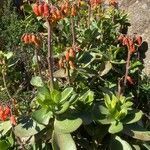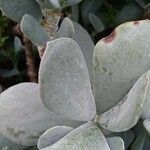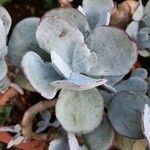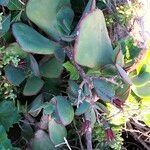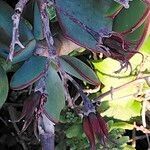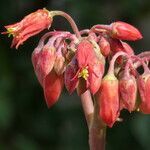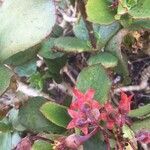Succulent subshrub with short, thick stem, often branched and forming clumps. Lvs opposite, sometimes subrosulate, ± vertical, sessile, to 11 × 9 cm, 5-12-(15) mm thick near middle, broadly obovate, very rarely narrow-oblong, ± concave above and convex beneath, entire, green with dense covering of white bloom; margin usually reddish purple; apex rounded and often ± mucronate. Flowering stems to c. 50 cm high, purplish and covered with white bloom. Cymes of few to many pendent fls; bracts 0.5-2 cm long. Sepals 3-5 mm long, triangular, green or ± red, covered with white bloom. Corolla 3-4-(4.7) cm long, orange or orange-red; tube c. ⅔ length of corolla, broadly cylindric and shallowly ribbed, with some bloom outside; lobes becoming reflexed, acute. Stamens 2-2.5 cm long, yellow. Styles 1.5-2 cm long, green. Scales 2-2.5 mm long, oblong, triangular-ovate to almost square. Follicles 2-3 cm long. Seeds 0.5-0.8 mm long, oblong, longitudinally ribbed.
Variable species. Shrub, ± branched, erect, ± 1.5 m high. Leaves obovate to oblanceolate to narrowly linear, 50-140 x 10-50 mm, cuneate, rounded or cuspidate, dorsiventrally flattened, slightly convex on both sides to terete, glabrous to hairy, green or grey, red or pale margins. Inflorescence a tall, erect thyrse with 3-5 dichasia, each with many flowers; peduncle 0.2-0.5 m long, glabrous to hairy. Calyx: lobes narrowly triangular, 2-5 mm long, acute, glabrous, rarely hairy. Corolla deep red to orange; tube cylindrical, 8-30 mm long, bulging in middle, glabrous; lobes lanceolate, recurved or recoiled shorter than tube. Flowering time Oct.-Jan.
Succulent shrublet, up to 1 m tall. Leaves linear to broadly obovate, 40-100 x 10-50 mm, terete to dorsiventrally flattened, smooth and not sticky. Flowers in a stout, smooth inflorescence, nodding; corolla orange to red, glaucous, smooth and not sticky, tube 8-30 mm long, lobes 12-20 mm long.
Succulent shrub to 1 m. Leaves obovate to narrowly ovoid, sometimes velvety, with a grey bloom. Flowers several in a stout, pedunculate cyme, nodding, reddish, filaments hairy below.
A succulent herb.
